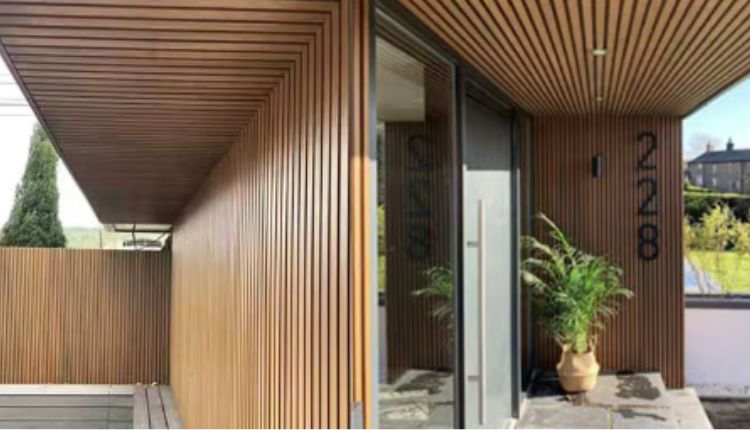As the demand for sustainable and high-performance building materials increases, composite cladding panels have become a popular choice for homeowners and designers alike. These innovative panels offer an array of benefits, combining eco-friendliness, durability, and stylish design into one cohesive package. Whether you’re renovating your home or building from scratch, upgrading to composite cladding panels can transform the appearance and functionality of your walls, inside and out. Let’s explore why composite cladding panels are the ideal solution for modern homes.
What Are Composite Cladding Panels?
Composite cladding panels are made from a mixture of natural wood fibers and synthetic materials like plastic. This combination creates a product that is both lightweight and highly durable, mimicking the appearance of wood while offering the resilience of synthetic materials. These panels can be used for both interior and exterior applications, providing an eco-friendly and cost-effective alternative to traditional materials like timber, stone, or metal. The design possibilities are endless, allowing for a wide range of finishes, textures, and colors to suit any style.
Why Choose Composite Cladding Panels?
- Eco-Friendly Choice
One of the main reasons homeowners are choosing composite cladding panels is their environmentally friendly nature. Made from a combination of recycled materials, composite cladding offers a sustainable solution for wall finishes. The use of recycled wood fibers and plastics means fewer natural resources are consumed, and less waste ends up in landfills.
Unlike traditional timber, which often requires the cutting down of trees, composite cladding helps preserve forests by utilizing recycled materials that would otherwise go to waste. Additionally, many composite cladding manufacturers employ responsible sourcing practices, ensuring that their products are produced with minimal environmental impact.
Opting for composite cladding also contributes to reducing your carbon footprint. By choosing a sustainable material that requires less maintenance and lasts longer, you are making an environmentally conscious choice that aligns with the growing trend towards greener, more eco-friendly living.
- Durability That Lasts
Durability is one of the primary advantages of composite cladding panels. Unlike natural wood, which can warp, rot, or suffer from weathering, composite cladding is engineered to withstand harsh conditions and maintain its beauty over time. These panels are highly resistant to moisture, insects, and UV rays, ensuring that your walls stay in excellent condition for many years.
For outdoor applications, composite cladding is particularly valuable. It can endure exposure to rain, wind, and sun without losing its integrity. Unlike traditional wood cladding, which may require regular sealing or staining, composite cladding maintains its color and appearance without the need for constant upkeep.
Composite panels are also resistant to fading, so your exterior walls will retain their vibrant color, regardless of the weather. This means you won’t need to worry about peeling paint, rotting wood, or the need for periodic refinishing, which is common with other materials. Whether you’re using composite cladding indoors or outdoors, its durability will ensure that it continues to look pristine for years to come.
- Low Maintenance
One of the biggest selling points of composite cladding panels is their minimal maintenance requirements. Unlike natural wood, which needs regular sealing, staining, or painting to maintain its appearance, composite panels are virtually maintenance-free. All that’s needed is a periodic cleaning with water and soap to remove any dirt or debris.
This ease of maintenance is especially beneficial for busy homeowners or those with large properties. Composite cladding ensures that your walls look great with minimal effort. This also saves both time and money over the long term, as you won’t need to invest in expensive maintenance or replacement materials.
Additionally, composite cladding is resistant to mold, mildew, and rot, which are common issues in more humid climates. This makes it a perfect solution for areas like kitchens, bathrooms, or homes located in rainy regions where moisture could otherwise damage traditional wall materials.
- Stylish and Versatile Designs
In addition to their functional benefits, composite cladding panels offer a wide variety of aesthetic options that can suit any design preference. Whether you’re looking for a modern, sleek finish or a more rustic, natural appearance, there’s a composite cladding style to fit your needs.
Many composite cladding panels are designed to mimic the look and texture of wood, but without the drawbacks of real timber. You can choose from a wide range of wood finishes, from rich mahogany and walnut to lighter tones like oak or ash. These panels can be installed horizontally, vertically, or in unique patterns to create a dynamic and contemporary look.
For those who prefer a more industrial or modern aesthetic, composite cladding panels are also available in smooth, minimalist finishes that resemble stone or metal. The versatility of composite cladding means that you can easily integrate it into various design schemes, whether you’re aiming for a traditional, contemporary, or even coastal-inspired look.
Moreover, composite cladding is available in a range of colors and finishes that can be tailored to match your interior or exterior color palette. This allows you to create a cohesive and personalized design that enhances the overall ambiance of your space.
- Energy Efficiency
Composite cladding panels can also contribute to the energy efficiency of your home. The materials used in composite panels provide a level of insulation that helps regulate indoor temperatures. In colder climates, composite cladding can help reduce heat loss, while in warmer climates, it can keep your home cooler by blocking out excessive heat from the sun.
Additionally, the insulation properties of composite cladding can reduce the need for heating and cooling, which can result in lower energy bills. This is an added benefit that makes composite cladding not only a stylish and durable choice but also a cost-effective one in the long run.
- Increase Property Value
Investing in high-quality composite cladding can also increase the value of your property. As a modern and eco-friendly material, composite cladding is highly attractive to potential buyers who are looking for low-maintenance, durable, and energy-efficient homes. The sleek and stylish appearance of composite cladding adds curb appeal, making your home stand out in the real estate market.
For those who are renovating to sell, the addition of composite cladding can make a significant difference in the final selling price of your home. Even if you’re not planning to sell, the enhanced appearance and durability of composite cladding will increase your home’s value in the long term.
How to Incorporate Composite Cladding into Your Home
Conclusion
Upgrading to composite cladding panels offers homeowners a variety of benefits that go beyond just aesthetics. These eco-friendly, durable, and low-maintenance materials are an excellent choice for anyone looking to enhance their living space while contributing to a sustainable future. Whether you’re looking to revamp your home’s exterior, create a stylish interior feature, or increase the value of your property, composite cladding provides the perfect solution.






